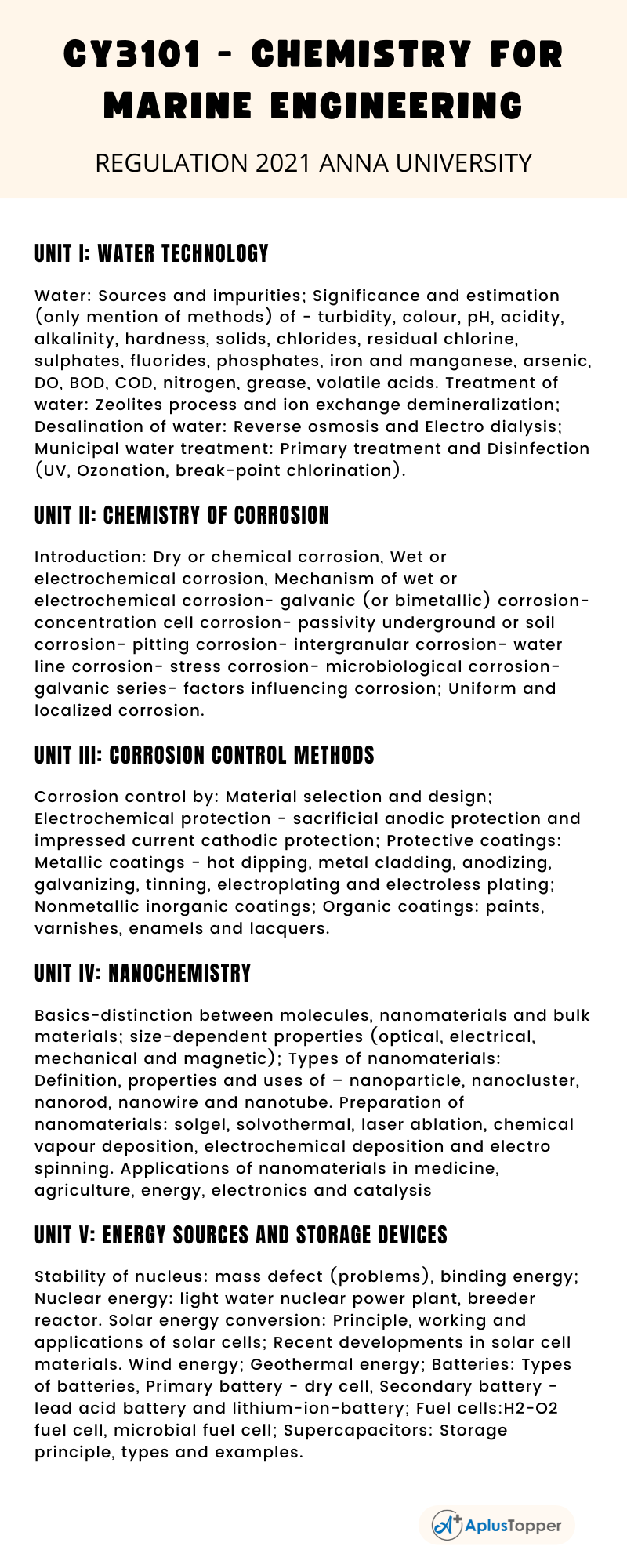Chemistry For Marine Engineering is a dynamic subject that continuously shifts from one perspective to another. However, the technicality is the same even if the theories and perspectives vary. Hence to gain knowledge in this subject you must be equipped with more vicious on the syllabus.
In this article, we tried to provide the required syllabus of the CY3101 Chemistry For Marine Engineering subject to gain command of the subject matter. By the end of the course, you will be trained and guided with useful knowledge regarding technical english, which plays a major role in understanding the core of this B.E Marine Engineering semester I related to Affiliated institutions awarded by Anna University course. Hope this information is useful. Kindly share it with your friends. Comment below if you have queries regarding the syllabus.
If you want to know more about the syllabus of B.E. Marine Engineering connected to an affiliated institution’s four-year undergraduate degree program. We provide you with a detailed Year-wise, semester-wise, and Subject-wise syllabus in the following link B.E. Marine Engineering Syllabus Regulation 2021 Anna University.
Aim Of Concept:
- To inculcate sound understanding of water quality parameters and water treatment techniques.
- To introduce the basic concepts on the chemistry and mechanism of different types of corrosion of materials.
- To facilitate the understanding of various corrosion control methods.
- To impart knowledge on the basic principles and preparatory methods of nanomaterials.
- To familiarize the students with the operating principles, working processes and applications of energy conversion and storage devices.
CY3101 – Chemistry For Marine Engineering Syllabus
Unit I: Water Technology
Water: Sources and impurities; Significance and estimation (only mention of methods) of – turbidity, colour, pH, acidity, alkalinity, hardness, solids, chlorides, residual chlorine, sulphates, fluorides, phosphates, iron and manganese, arsenic, DO, BOD, COD, nitrogen, grease, volatile acids. Treatment of water: Zeolites process and ion exchange demineralization; Desalination of water: Reverse osmosis and Electro dialysis; Municipal water treatment: Primary treatment and Disinfection (UV, Ozonation, break-point chlorination).
Unit II: Chemistry Of Corrosion
Introduction: Dry or chemical corrosion, Wet or electrochemical corrosion, Mechanism of wet or electrochemical corrosion- galvanic (or bimetallic) corrosion- concentration cell corrosion- passivity underground or soil corrosion- pitting corrosion- intergranular corrosion- water line corrosion- stress corrosion- microbiological corrosion- galvanic series- factors influencing corrosion; Uniform and localized corrosion.
Unit III: Corrosion Control Methods
Corrosion control by: Material selection and design; Electrochemical protection – sacrificial anodic protection and impressed current cathodic protection; Protective coatings: Metallic coatings – hot dipping, metal cladding, anodizing, galvanizing, tinning, electroplating and electroless plating; Nonmetallic inorganic coatings; Organic coatings: paints, varnishes, enamels and lacquers.
Unit IV: Nanochemistry
Basics-distinction between molecules, nanomaterials and bulk materials; size-dependent properties (optical, electrical, mechanical and magnetic); Types of nanomaterials: Definition, properties and uses of – nanoparticle, nanocluster, nanorod, nanowire and nanotube. Preparation of nanomaterials: solgel, solvothermal, laser ablation, chemical vapour deposition, electrochemical deposition and electro spinning. Applications of nanomaterials in medicine, agriculture, energy, electronics and catalysis

Unit V: Energy Sources And Storage Devices
Stability of nucleus: mass defect (problems), binding energy; Nuclear energy: light water nuclear power plant, breeder reactor. Solar energy conversion: Principle, working and applications of solar cells; Recent developments in solar cell materials. Wind energy; Geothermal energy; Batteries: Types of batteries, Primary battery – dry cell, Secondary battery – lead acid battery and lithium-ion-battery; Fuel cells:H2-O2 fuel cell, microbial fuel cell; Supercapacitors: Storage principle, types and examples.
Text Books:
- P. C. Jain and Monica Jain, “Engineering Chemistry”, 17th Edition, DhanpatRai Publishing Company (P) Ltd, New Delhi, 2018.
- Sivasankar B., “Engineering Chemistry”, Tata McGraw-Hill Publishing Company Ltd, New Delhi, 2008.
- S.S.Dara, “A text book of Engineering Chemistry”, S. Chand Publishing, 12th Edition, 2016.
References:
- B. S. Murty, P. Shankar, Baldev Raj, B. B. Rath and James Murday, “Text book of nanoscience and nanotechnology”, Universities Press-IIM Series in Metallurgy and Materials Science, 2018.
- O.G. Palanna, “Engineering Chemistry” McGraw Hill Education (India) Private Limited, 2nd Edition, 2017.
- Friedrich Emich, “Engineering Chemistry”, Scientific International PVT, LTD, New Delhi, 2014.
- Shikha Agarwal, “Engineering Chemistry-Fundamentals and Applications”, Cambridge University Press, Delhi, Second Edition, 2019.
- O.V. Roussak and H.D. Gesser, Applied Chemistry-A Text Book for Engineers and Technologists, Springer Science Business Media, New York, 2nd Edition, 2013.
Related Posts On Semester – I:
- IP3151 – Induction Programme
- HS3101 – Technical English for Marine Engineers – I
- MA3101 – Mathematics for Marine Engineering – I
- PH3151 – Engineering Physics
- GE3151 – Problem Solving and Python Programming
- GE3152 – தமிழர்மரபு /Heritage of Tamils
Must Read For More:
